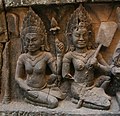Bajon (styl)
Wygląd
Bajon – styl architektoniczny oraz styl w sztuce XII i XIII wieku, obecny m.in. w kompleksie świątyń Angkor Wat[1] w Kambodży oraz w Tajlandii[2][3].
Charakterystyka
[edytuj | edytuj kod]Styl wykształcił się w czasach rozkwitu sztuki khmerskiej[4] pod koniec XII wieku oraz na początku XIII wieku[5][6] (lata 1181–1243[7]). Jego cechami były m.in. monumentalizm, zastosowanie wielu wież, przedstawianie tancerek i innych postaci z zagadkowym uśmiechem Buddy i półprzymkniętymi oczami[5]. Powrócono także do wznoszenia dvarapali[8].
W 1965 roku ukazała się książka Philippe'a Sterna na temat budynków wzniesionych w stylu Bajon[9].
Realizacje
[edytuj | edytuj kod]Szczytowe osiągnięcia stylu Bajon to[5]:
- świątynia Bajon
- zabudowa Banteai Czmar ze świątynią Ta Prohm[10]
- świątynia Banteay Kdei
- stanowisko archeologiczne Ta Som
- świątynia Preah Khan
- Tarasy Królewskie (Taras Trędowatego Króla i Taras Słoni)
Galeria
[edytuj | edytuj kod]-
Świątynia Bajon
-
Świątynia Ta Prohm
-
 Świątynia Banteay Kdei
Świątynia Banteay Kdei -
 Płaskorzeźba z Ta Som
Płaskorzeźba z Ta Som -
Świątynia Preah Khan
-
 Płaskorzeźba z Tarasu Trędowatego Króla
Płaskorzeźba z Tarasu Trędowatego Króla
Przypisy
[edytuj | edytuj kod]- ↑ Michael Falser, Monica Juneja, 'Archaeologizing' Heritage?: Transcultural Entanglements between Local Social Practices and Global Virtual Realities, Springer Science & Business Media, 31 maja 2013, s. 168, ISBN 978-3-642-35870-8 (ang.).
- ↑ Olivier Cunin, A Study of Wooden Structures: A Contribution to the Architectural History of the Bayon Style Monuments, [w:] Veronique Degroot, Marijke J. Klokke, Materializing Southeast Asia's Past: Selected Papers from the 12th International Conference of the European Association of Southeast Asian Archaeologists, NUS Press, 1 maja 2013, s. 82, ISBN 978-9971-69-655-9 (ang.).
- ↑ Master Plan for the Conservation & Restoration of the Bayon Complex, Japan International Cooperation Center (JICE), 2005, s. 540 [dostęp 2023-11-17] (ang.).
- ↑ G. Coedès, The Making of South East Asia, Univ of California Press, 10 listopada 2023, s. 122, ISBN 978-0-520-31328-6 [dostęp 2023-11-17] (ang.).
- ↑ a b c John Audric, Angkor i imperium khmerskie, Teresa Białogórska (tłum.), Warszawa: Państw. Inst. Wydaw, 1979, s. 160, ISBN 978-83-06-00090-0.
- ↑ Andrea Acri, Peter Sharrock, The Creative South: Buddhist and Hindu Art in Mediaeval Maritime Asia, volume 1, ISEAS-Yusof Ishak Institute, 12 kwietnia 2022, s. 359, ISBN 978-981-4951-49-4 (ang.).
- ↑ Cambodia, PediaPress, s. 262 (ang.).
- ↑ Helena A. van Bemmel, Dvarapalas in Indonesia: Temple Guardians and Acculturation, CRC Press, 1994, s. 96, ISBN 978-90-5410-155-0 (ang.).
- ↑ Hiram Woodward, The Art and Architecture of Thailand: From Prehistoric Times through the Thirteenth Century, BRILL, 24 grudnia 2018, s. 203, ISBN 978-90-474-0774-4 (ang.).
- ↑ Derrick Fludd, Siem Reap Cambodia, Global Image Books, 12 marca 2017, s. 95 [dostęp 2023-11-17] (ang.).






